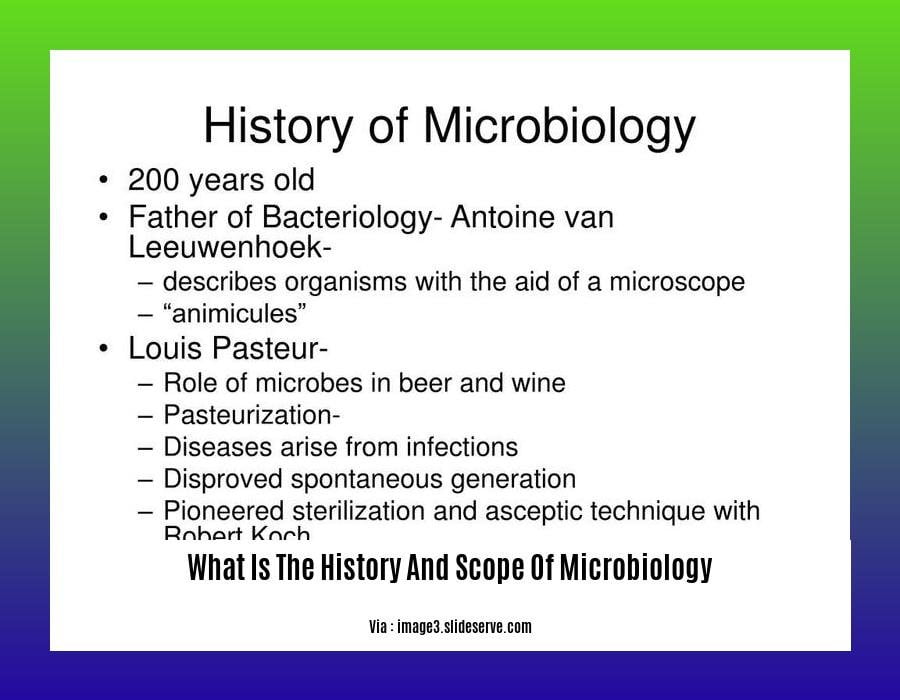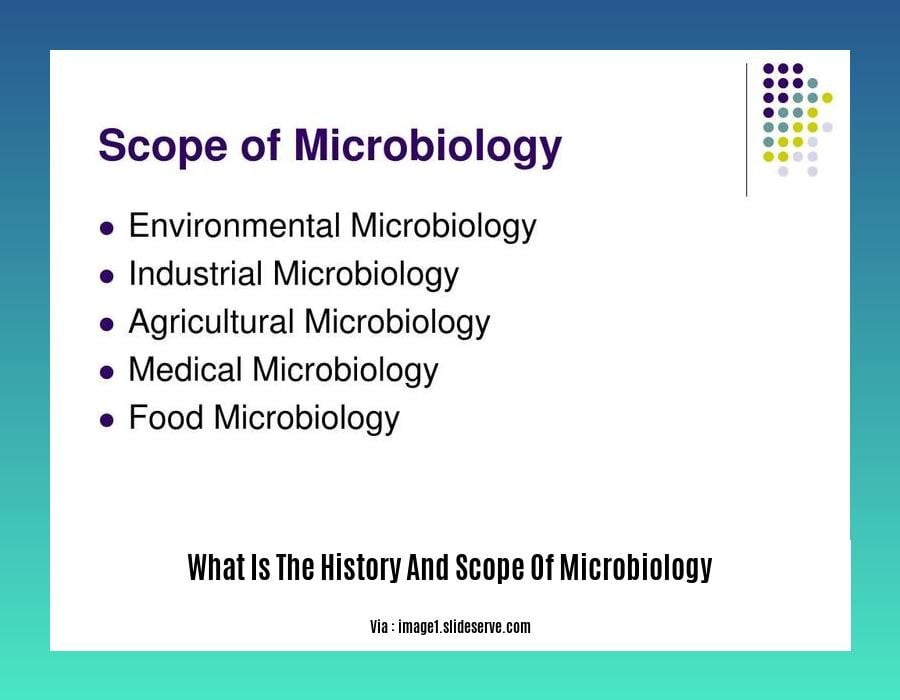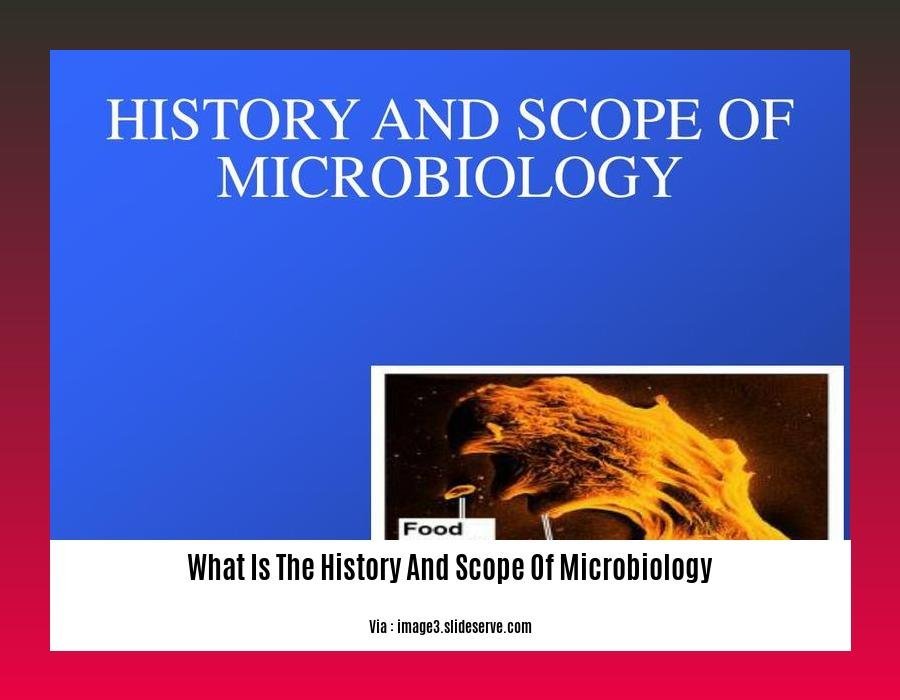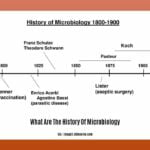Embark on a microscopic odyssey with [What Is the History and Scope of Microbiology: Unveiling the Microcosm’s Influence on Life]. This article delves into the fascinating realm of microorganisms, exploring their profound impact on life as we know it.
Key Takeaways:
Microbiology studies microorganisms, which include bacteria, archaea, algae, fungi, protozoa, and viruses.
Microbiology has a rich history and dates back before the invention of the microscope.
Microorganisms play essential roles in food production, medicine, and environmental processes.
Some microorganisms are pathogenic and can cause disease, while others are beneficial and used in various industries.
Examples of Microorganisms:
- Bacteria: Tiny single-celled organisms with crucial roles in nutrient cycling, decomposition, and industrial processes.
Fungi: Eukaryotes that include yeasts, molds, and mushrooms. They are important decomposers and find applications in food production, pharmaceuticals, and biotechnology.
Microorganisms in Food Production:
- Microorganisms are used in fermentation processes to make yogurt, cheese, and beer.
- They also aid in microbial ripening (like in cheese) and the conversion of plant materials into food additives and supplements.
Microorganisms can cause food spoilage and contamination, and food microbiology focuses on preventing foodborne illnesses.
Scope of Microbiology:
- Medical Microbiology:
- Deals with disease-causing microorganisms in humans, animals, and plants.
- Involves developing diagnostic techniques, antibiotics, and vaccines.
- Environmental Microbiology:
- Studies microorganisms in the environment and their role in ecosystems.
- Includes bioremediation and studying the impact of humans on microbial communities.
- Industrial Microbiology:
- Uses microorganisms in industrial processes like fermentation, antibiotic production, and biofuel production.
- Food Microbiology:
- Explores microorganisms involved in food production, spoilage, and safety.
- Helps develop food preservation techniques and quality control measures.
What Is The History And Scope Of Microbiology

Delve into the Realm of Microorganisms: Exploring the Past, Present, and Future of Microbiology
From the tiniest bacteria to the intricate world of viruses, microorganisms are an integral part of our planet’s ecosystem. What Is The History And Scope Of Microbiology takes us on a captivating journey through the history of this scientific field and unveils the profound impact of microorganisms on life as we know it.
The Dawn of Microbiology: A Timeline of Discoveries
The study of microorganisms has come a long way since the invention of the microscope in the 16th century. Pioneering scientists like Antonie van Leeuwenhoek opened up a new realm of exploration, revealing the existence of tiny creatures previously unseen by the naked eye. These discoveries laid the foundation for the field of microbiology, propelling scientists on an ever-evolving quest for knowledge about the microbial world.
Unraveling the Microbial Tapestry: Branches of Microbiology
Microbiology encompasses a diverse range of disciplines, each focusing on a specific aspect of microbial life. From medical microbiology, which investigates disease-causing microorganisms, to environmental microbiology, which delves into the role of microorganisms in ecosystems, each branch contributes to our understanding of these tiny organisms.
Microbes: Friend or Foe? Their Impact on Our Lives
Microorganisms play a multifaceted role in our lives. They can be both beneficial and harmful. On one hand, they are essential for food production, antibiotic development, and various industrial processes. On the other hand, they can cause diseases and food spoilage, posing a threat to human health. Understanding the complex interplay between microorganisms and our lives is crucial for maintaining a harmonious balance.
The Future of Microbiology: Uncharted Territories
Microbiology continues to break new ground, with scientists constantly pushing the boundaries of knowledge. From the exploration of extremophiles in harsh environments to the development of novel antibiotics to combat antimicrobial resistance, the future of microbiology holds immense promise for addressing global challenges and shaping our understanding of life on Earth.
Unravel the fascinating journey of microbiology through the ages by delving into the history of microbiology and discovering the milestones that shaped our understanding of the microbial world.
Embark on an enlightening exploration of the history of microbiology, tracing the footsteps of pioneers who unlocked the secrets of the unseen realm of microorganisms.
Uncover the intriguing historical background of microbiology and witness how the study of microbes revolutionized our perception of life and medicine, leading to groundbreaking advancements in human health.
Microorganisms and the Environment: Examining the Vital Role of Microorganisms in Ecosystems, Biogeochemical Cycles, and Climate Regulation

Dive into the fascinating world of microorganisms and their profound impact on the environment. From microscopic marvels to the grand scales of ecosystems, we’ll explore the vital role that these tiny organisms play in sustaining life on Earth. Get ready to uncover the intricate web of interactions that connect microorganisms and the environment.
Key Takeaways:
Environmental Guardians: Microorganisms, like bacteria, fungi, and archaea, are responsible for maintaining the delicate balance of ecosystems. They decompose organic matter, recycle nutrients, and protect against harmful substances.
Biogeochemical Jugglers: These tiny players drive essential biogeochemical cycles, including carbon, nitrogen, and phosphorus cycling. Their actions ensure the continuous flow of nutrients through ecosystems, supporting plant growth and maintaining the health of our planet.
Climate Champions: Microorganisms influence climate regulation by mediating greenhouse gas emissions and participating in carbon sequestration. Their activities can either amplify or mitigate climate change, highlighting their pivotal role in shaping our planet’s climate.
Bioremediation Soldiers: Microorganisms have remarkable abilities to clean up environmental messes. They break down pollutants, detoxify contaminated sites, and restore the health of ecosystems. Their potential in bioremediation offers hope for addressing environmental disasters.
Sustainable Solutions: Microorganisms are a promising source of sustainable solutions. They can produce biofuels, bioplastics, and other eco-friendly materials, reducing our reliance on fossil fuels and promoting a circular economy.
As we delve deeper into the world of microorganisms and the environment, we uncover the immense significance of these tiny organisms. Their contributions to nutrient cycling, climate regulation, bioremediation, and sustainable solutions are undeniable. Embracing the power of microorganisms can lead us towards a greener, healthier future for our planet.
Sources:
- The Role of Microorganisms in the Environment
- Microorganisms and Climate Change: Impacts, Feedbacks, and Mitigation
Microorganisms and Human health: investigating the complex interactions between microorganisms and human health, including beneficial and pathogenic relationships.
Microbes! The Invisible Allies and Foes of Our Health:
We’re surrounded by a world of invisible microorganisms that play a complex dance with our health. From the microscopic guardians that protect us to the stealthy invaders that cause disease, the realm of microbiology holds profound implications for human well-being.
Beneficial Microbes: A Symphony of Health
Bacteria, viruses, and fungi aren’t all bad news. In fact, trillions of beneficial microbes call our bodies home, forming a diverse community known as the microbiome.
1. Microbes & Digestion:
These microbial helpers break down food and synthesize vitamins, aiding in digestion and nutrient absorption.
2. Immune Defenders:
Our microbial allies train our immune system to recognize and fight harmful invaders, helping us stay healthy.
3. Mental Well-being:
Emerging research suggests that gut microbes may influence our mental health, potentially affecting mood and behavior.
Pathogenic Microbes: The Unseen Adversaries
While many microbes are beneficial, some can cause disease. Here’s how they wage their microscopic warfare:
1. Infections:
Pathogenic microbes, like bacteria and viruses, can invade our bodies, causing infections. These infections can range from mild to life-threatening.
2. Toxins:
Some microbes produce toxins, harmful substances that can damage cells and tissues, leading to disease.
3. Antimicrobial Resistance:
Overuse and misuse of antibiotics have led to the rise of antimicrobial resistance, making it harder to treat infections.
Striving for Harmony: Balancing the Microbial Ecosystem
Maintaining a healthy balance between beneficial and harmful microbes is crucial for our overall well-being. Here are some tips to nurture a harmonious microbial ecosystem:
1. Healthy Diet:
A diet rich in fruits, vegetables, and fermented foods supports a diverse microbiome.
2. Mindful Antibiotic Use:
Use antibiotics only when necessary and as prescribed by a healthcare professional to prevent antibiotic resistance.
3. Hygiene Practices:
Good hygiene practices, like handwashing and proper food handling, help prevent the spread of harmful microbes.
The Future of Microbe-Human Interactions:
Microbiology continues to unveil the intricate tapestry of microbe-human interactions, leading to groundbreaking advancements in healthcare and beyond:
1. Microbiome-Targeted Therapies:
Researchers are exploring ways to manipulate the microbiome to treat diseases, such as inflammatory bowel disease and obesity.
2. Antimicrobial Development:
The search for new antibiotics continues, aiming to combat antimicrobial resistance and protect against emerging infectious threats.
3. Environmental Stewardship:
Understanding the role of microbes in the environment helps us protect ecosystems and prevent the spread of zoonotic diseases.
Key Takeaways:
- Microbes play a dual role in human health, both as beneficial allies and potential pathogens.
- Beneficial microbes aid digestion, support the immune system, and influence mental well-being.
- Pathogenic microbes cause infections, produce toxins, and contribute to antimicrobial resistance.
- Maintaining a healthy microbial balance is essential for overall well-being.
- Ongoing research explores microbiome-targeted therapies, antimicrobial development, and environmental stewardship to harness the power of microbes for human health.
Sources:
[1] https://www.ncbi.nlm.nih.gov/pmc/articles/PMC7306068/ (The Human Microbiome: Its Impact on Health and Implications for Research and Therapeutic Applications)
[2] (Centers for Disease Control and Prevention: Microbes)
Microorganisms in industry: uncovering the applications of microorganisms in various industries, such as food production, pharmaceuticals, and bioremediation.
The world of microorganisms is vast and teeming with life, playing a pivotal role in various industries, from food production to pharmaceuticals and bioremediation. These tiny organisms, invisible to the naked eye, possess remarkable capabilities that have revolutionized industries and improved our lives in countless ways. Let’s delve into the fascinating world of microorganisms and explore their diverse applications across industries.
Key Takeaways:
Microorganisms have been harnessed for centuries in the food industry, contributing to the production of fermented foods like cheese, yogurt, and beer.
Modern biotechnology has opened up new avenues for microorganisms in industry, enabling the production of probiotics, prebiotics, and enzymes that enhance food quality and safety.
Pharmaceuticals have witnessed the transformative power of microorganisms, with antibiotics like penicillin revolutionizing the treatment of infectious diseases.
Microorganisms are also instrumental in waste management, bioremediation, and the production of biofuels, offering sustainable solutions to environmental challenges.
The versatility of microorganisms extends to the development of bioplastics, biopolymers, and bio-based chemicals, promoting a circular economy and reducing reliance on fossil fuels.
Microorganisms in industry** have far-reaching applications, impacting various sectors and driving innovation for a more sustainable and prosperous future.
Microorganisms in Food Production: A Culinary Symphony
Microorganisms have been culinary partners for millennia, transforming raw ingredients into delectable treats. Fermentation, a process driven by microorganisms, has gifted us with a symphony of flavors and texturas in foods like cheese, yogurt, beer, wine, and bread. These tiny helpers enhance food quality, extend shelf life, and contribute to the unique characteristics that make each food item special.
Microorganisms in Pharmaceuticals: A Lifesaving Alliance
The discovery of penicillin, a serendipitous encounter between Alexander Fleming and a mold, marked a turning point in human health. Antibiotics, derived from microorganisms, have become powerful weapons against infectious diseases, saving countless lives. Microorganisms continue to inspire the development of new drugs, vaccines, and treatments, offering hope in the fight against various ailments.
Microorganisms in Bioremediation: Nature’s Cleanup Crew
Microorganisms are nature’s cleanup crew, tirelessly breaking down pollutants and contaminants in soil, water, and air. Bioremediation, a process harnessing the power of microorganisms, offers a sustainable solution to environmental contamination. These microbial helpers degrade hazardous substances, restore ecosystems, and pave the way for a cleaner and healthier environment.
Microorganisms in Industry: A Sustainable Future
The applications of microorganisms in industry extend far beyond food, pharmaceuticals, and bioremediation. These versatile organisms are also involved in the production of bioplastics, biopolymers, and bio-based chemicals. These sustainable alternatives to traditional materials reduce our reliance on fossil fuels, promote circular economies, and contribute to a greener future.
Citations:
Microbial Biotechnology in Food and Health
Industrial Applications of Microorganisms
















